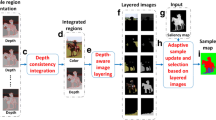Abstract
High-resolution satellite images, especially of urban areas, are complex in nature. Presence of multiple objects renders analysis of such images challenging. As human mind is best in dealing with complex images and ambiguous problems, such urban area satellite images can be best interpreted by development of such systems that can emulate human mind. Therefore, the presented work separates the high-resolution satellite images into foreground and background on the basis of saliency for simulating human-like segmentation. This work exploits the existing saliency methods available along with segmentation algorithm. Results have been analyzed on the basis of the robustness of ‘shape’ which is a key factor for object recognition. Presented work also propose a measure to assess the goodness of the segmented images which is based on similar segmentation of terrestrial images in a separate work.
Access this chapter
Tax calculation will be finalised at checkout
Purchases are for personal use only
Similar content being viewed by others
References
Achanta, Radhakrishna, Francisco Estrada, Patricia Wils, and Sabine Ssstrunk. 2008. Salient Region Detection and Segmentation. Lecture Notes in Computer Science Computer Vision Systems, Vol. 5008, pp. 66–75. https://doi.org/10.1007/978-3-540-79547-6_7.
Achanta, R., S. Hemami, F. Estrada, and S. Susstrunk. 2009. Frequency-Tuned salient region detection. 2009 IEEE Conference on Computer Vision and Pattern Recognition. pp. 1597–1604. https://doi.org/10.1109/cvprw.2009.5206596.
Achanta R, Shaji A, Smith K, Lucchi A, Fua P and Ssstrunk S 2010, “SLIC Superpixels” EPFL.
Diao Wenhui, Sun Xian, Zheng Xinwei, Dou Fangzheng, Wang Hongqi and Fu Kun,2016. “Efficient Saliency-Based Object Detection in Remote Sensing Images Using Deep Belief Networks.” IEEE Geoscience and Remote Sensing Letters. vol. 13, no. 2, pp. 137–141.
Erdem, E., and A. Erdem. 2013. Visual saliency estimation by nonlinearly integrating features using region covariances. Journal of Vision 13 (4): 1111. https://doi.org/10.1167/13.4.11.
Estes J. 1983. “Manual of remote sensing.” American society for photogrammetry and remote sensing.
Fischer Thomas, Sven-Thomas Graupner, Boris M. Velichkovsky, and Sebastian Pannasch. 2013. Attentional dynamics during free picture viewing: Evidence from oculomotor behavior and electrocortical activity. Frontiers in Systems Neuroscience 7. https://doi.org/10.3389/fnsys.2013.00017.
Frintrop Simone. 2011. “Computational Visual Attention.” Computer Analysis of Human Behavior, 69101. https://doi.org/10.1007/978-0-85729-994-9_4.
Goferman Stas, Lihi Zelnik-Manor, and Ayellet Tal. 2010. “Context-Aware saliency detection.” IEEE Computer Society Conference on Computer Vision and Pattern Recognition. https://doi.org/10.1109/cvpr.2010.5539929.
Harel J., Koch C., and Perona Pietro, 2006, “Graph-Based Visual Saliency”, Proceedings of Neural Information Processing Systems (NIPS), pp. 545–552.
Itti Laurent, Koch Christof, and Niebur Ernst, 1998, “A Model of Saliency-Based Visual Attention for Rapid Scene Analysis”, IEEE Transactions on Pattern Analysis and Machine Intelligence, Vol. 20, Issue 11, 1254-1259.
Li Er, Xu Shibiao , Meng Weiliang and Zhang Xiaopeng, 2017. “Building Extraction from Remotely Sensed Images by Integrating Saliency Cue”, IEEE Journal of Selected Topics in Applied Earth Observations and Remote Sensing, vol. 10, no. 3, pp. 906-919.
Margolin Ran, Manor Lihi Zelnik, Tal Ayellet, 2013, “Saliency for Image Manipulation”, The Visual Computer, International Journal of Computer Graphics, Volume 29, Issue 5, pp 381–392.
Ommer Bjrn, 2013, “The Role of Shape in Visual Recognition”, in Shape Perception in Human and Computer Vision, Springer London, pp 373–385.
Ooi W.S. and Lim S.P., 2006, “Hybrid Image Segmentation Based on Fuzzy Clustering Algorithm for Satellite Imagery Searching and Retrieval”, Applied Soft Computing Technologies, The Challenges of Complexity Advances in Soft Computing, Vol 34, pp. 355–372.
Pannasch Sebastian, Schulz Johannes, and Velichkovsky Boris M., 2011, “On the Control of Visual Fixation durations in Free Viewing of Complex Images”, Attention, Perception & Psychophysics, 73(4), pp. 1120–1132.
Riche Nicolas, Mancas Matei, Duvinage Matthieu, Mibulumukini Makiese, Gosselin Bernard, Dutoit Thierry, July 2013. “RARE2012: A Multi-Scale rarity-Based Saliency Detection with Its Comparative Statistical Analysis”, Signal Processing: Image Communication at Science Direct, Volume 28, Issue 6, pp 642–658 28.
Sharma Ashu and Ghosh Jayanata Kumar,2015. “Saliency Based Segmentation of Satellite Images”, ISPRS Ann. Photogramm. Remote Sens. Spatial Inf. Sci., II-3/W4, 207–214, https://doi.org/10.5194/isprsannals-II-3-W4-207-2015.
Sokolov E.N. and Nezlina N.I., 2010, Segmentation, Grouping and Accentuation during Stimulus perception, Neuroscience and Behavioral Physiology, Vol. 40, No. 3.
Stiefelhagen R. and Ekenel HK, (2011, April 04), “Content-Based Image and Video Retrieval”, Computer Vision for Human Computer Interaction Lab, Karlsruhe Institute of Technology, Germany.
Tavakoli Hamed Rezazadegan, Rahtu Esa, and Heikkila Janne, 2011. “Fast and Efficient Saliency Detection Using Sparse Sampling and Kernel Density Estimation”, Scandinavian Conference on Image Analysis (SCIA), Lecture Notes in Computer Science 6688, pp. 666–675.
Tian Minghui, Wan Shouhong and Yue Lihua, “A Novel Approach for Change Detection in Remote Sensing Image Based on Saliency Map”, Computer Graphics, Imaging and Visualisation (CGIV 2007), Bangkok, pp. 397–402.
Toet Alexander, August 2016, “Iterative guided image fusion”, PeerJ Computer Science 2:e80, Available: https://doi.org/10.7717/peerj-cs.80.
Toet Alexander, Nov 2011, “Computational versus psychophysical Bottom-Up Image Saliency: A Comparative Evaluation Study”, IEEE Transactions on Pattern Analysis and Machine Intelligence, Vol 33, Issue: 11, pp. 2131–2146.
Zhai Liang, Li Yu and Su Yi, 2016, “Inshore Ship Detection via Saliency and Context Information in High-Resolution SAR Images”,IEEE Geoscience and Remote Sensing Letters, Vol. 13, No.12, pp. 1870–1874.
Zhang Fan, Du Bo and Zhang Liangpei,2015, “Saliency-Guided Unsupervised Feature Learning for Scene Classification”, IEEE transactions on Geoscience and Remote Sensing, Vol 53, No.4 pp. 2175–2184.
Zhu Dan, Wang Bin and Zhang Liming, 2015,“Airport Target Detection in Remote Sensing Images: A New Method Based on Two-Way Saliency”, IEEE Geoscience and Remote Sensing Letters, Vol. 12, No.5, pp. 1096–1100.
Author information
Authors and Affiliations
Corresponding author
Editor information
Editors and Affiliations
Rights and permissions
Copyright information
© 2018 Springer Nature Singapore Pte Ltd.
About this paper
Cite this paper
Sharma, A., Ghosh, J.K. (2018). A Bottom-Up Saliency-Based Segmentation for High-Resolution Satellite Images. In: Chaudhuri, B., Kankanhalli, M., Raman, B. (eds) Proceedings of 2nd International Conference on Computer Vision & Image Processing . Advances in Intelligent Systems and Computing, vol 704. Springer, Singapore. https://doi.org/10.1007/978-981-10-7898-9_14
Download citation
DOI: https://doi.org/10.1007/978-981-10-7898-9_14
Published:
Publisher Name: Springer, Singapore
Print ISBN: 978-981-10-7897-2
Online ISBN: 978-981-10-7898-9
eBook Packages: EngineeringEngineering (R0)




